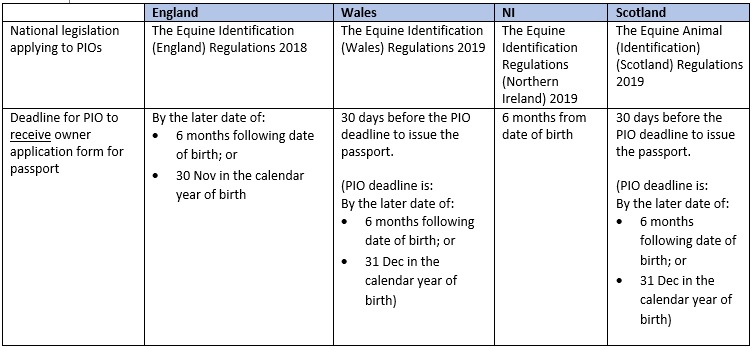Introduction to passports
What is Defra's Central Equine Database (CED)?
What do I need to know about getting a passport for my horse?
Where can I get an equine passport?
Do I need to have my horse microchipped?
What makes an equine passport compliant in the UK?
How long does an equine passport last?
Who do I contact to make an enquiry or a complaint about the service I received?
What’s the purpose of an equine passport?
Passports are used to:
- Identify an equine.
- Provide details of ownership and help to manage equine movements in the event of a disease outbreak.
- Ensure that equines containing substances not permitted in food producing animals, such as Phenylbutazone (bute), are kept out of the food chain.
An equine passport must always remain with the equine. This includes:
- at their stable or yard
- when you move them
- when a vet examines your equine or treats it with medication
- at the time the equine is sold, when the passport must be passed on to the new owner
- when the equine is used for breeding
- when the equine is presented at a slaughterhouse
- when the equine leaves the United Kingdom
What is Defra’s Central Equine Database (CED)?
Managed by the Equine Register on behalf of Defra, the CED was established to create a more robust and enforceable equine identification (equine passport) system after EU member states endorsed proposals for stronger regulations. The CED holds over 1.2 million equine records from the 81 UK PIOs and all equines who live in the UK are legally required to be registered. You can manage all your horse's CED records by registering for a free Digital Stable account.
Not sure your horse is registerd? You can check if any horse is on the CED using the 'Chipchecker' facility on Equine Register's website.
All information updated by the BEF during a passport update is transferred automatically to CED.
More on the CED and Equine Register
What do I need to know about getting a passport for my horse?
All horses, ponies, and donkeys, with very few exceptions, must have a passport regardless of whether they travel or not. This is stated in the following regulations:
- England: The Equine Identification (England) Regulations 2018
- Scotland: The Equine Animal (Identification) (Scotland) Regulations 2019
- Wales: The Equine Identification (Wales) Regulations 2019
- Northern Ireland: The Equine Identification Regulations (Northern Ireland) 2019
You should apply for an equine passport within six months of birth, or by 31 December on the year of the foal’s birth, whichever is later.
Please note: the requirement to register a horse is governed by the location of the PIO to whom the owner submits an application.

An equine passport lasts for the lifetime of the equine and will be issued by PIOs approved by the Department for Environment, Food and Rural Affairs (DEFRA).
Where can I get an equine passport?
An equine passport may be issued by two types of Passport Issuing Organisation (PIO)...
- Studbook – issue passports for registered equines with a proven pedigree
- Identity only – issue passports for all other types of equine
A list of PIOs can found on Defra’s website.
Do I need to have my horse microchipped?
The microchipping law came into effect in June 2018 to help tackle abuse and improve animal welfare. All equines will need to be microchipped by law according to the timeline below, which varies slightly according to the location of the PIO to which your horse is registered:
England: 1 October 2020
Scotland: 28 March 2021
Wales: 12 February 2021
Civil sanctions can be applied, in addition to criminal sanctions, for failing to comply with these deadlines. Civil sanctions mean that anyone not complying by the deadline may be liable for a compliance notice, which may lead to a fixed penalty notice and a fine.
CED will allow local authorities and police to track down the owners, if an equine is found that has been lost, dumped, or stolen.
Microchips must be implanted by a qualified veterinary surgeon.
What makes an equine passport COMPLIANT in the uk?
A UK compliant passport should include the following pages:
- Formal identification
- Ownership
- Vaccinations
- Infectious disease testing
- Equine anti-doping and controlled medication testing
- Food consumption status (Section IX/II)
who do I CONTACT to make an enquiry or a complaint about the service I received?
If you have any queries, please contact the office on 02475 313 433 or email us at passports@bef.co.uk
For information on our written complaints and appeals procedure. please click here.